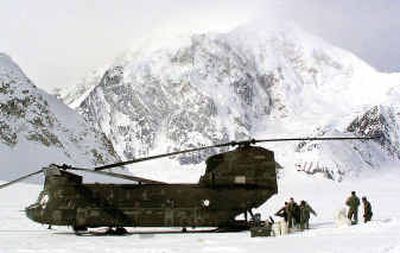Army altitude training peaks at Denali

MOUNT McKINLEY, Alaska — The Army Chinook helicopter hovered over the Kahiltna Glacier, its blades whipping the surface snow into a glittering white fog as it gingerly touched down.
Moments later, two other Chinooks joined the first at Mount McKinley’s 7,200-foot level. It was time for the Army’s yearly mission: delivering the makings of base camp for National Park Service rangers and most climbers tackling North America’s tallest peak.
Just before climbing season kicks off each May, the “Sugar Bears” — formally known as Company B, 4th Battalion, 123rd Aviation Regiment — haul food, communications equipment, body bags, prefabricated shelters and other essentials to the Kahiltna’s northeast fork, the launching point for climbers attempting the West Buttress route.
The Fort Wainwright-based team also drops off survival and rescue supplies at the 14,200-foot level — about two-thirds up the peak — where the elevation can lead to oxygen deprivation.
The effort is a training exercise for the regiment’s high-altitude rescue team. The team’s expertise also serves as a model for Army Chinook crews operating in the mountainous terrain of Afghanistan, said Lt. Col. Randolph Rotte, commander of the 4-123rd. Units heading to that country have contacted the Alaska team for guidance in dealing with high-altitude missions, Rotte said.
“Aircraft perform differently in thin air,” Rotte said. “There’s a pretty steep learning curve and in the aviation business you can’t afford a steep learning curve. That’s when bad things happen.”
The Park Service doesn’t have anything near the size of the Army Chinooks. It would take 10 trips on the park’s smaller chopper for every Chinook load, said Roger Robinson, lead mountaineering ranger for Denali National Park and Preserve.
“Without the Army’s help, it would not be happening like this,” Robinson said as soldiers worked against a backdrop of snow-marbled granite. The unloading began after rangers probed the snow to make sure there were no hidden chasms in the vicinity.
The soldiers moved quickly, their breath frosting the air. A few tossed wisecracks as they added to the growing pile of tarps, wooden slats and boxes.
The Park Service would later transform the mishmash of parts into a makeshift town for rangers and volunteers, and soon, a bustling hub for climbers. This will be the launching point for an estimated 95 percent of the 1,076 people who have signed up to tackle 20,320-foot Mount McKinley this season. It’s also a popular stop for hundreds of nonclimbing tourists who fly up on air taxis.
Robinson said the Park Service has enlisted the help of the unit since 1984, but has relied on the military to help with rescues for decades.
“Helping us with base camp allows us to have a safer season, and it allows the Army to train at high altitudes so they are proficient in being able to maneuver in rugged, mountainous conditions,” he said.
Later, crews practiced high-altitude rescue techniques.
In the highest rescue on McKinley, a Chinook carried rangers to 19,600 feet in June 1995 to pick up two Spanish climbers suffering from frostbite and altitude sickness.